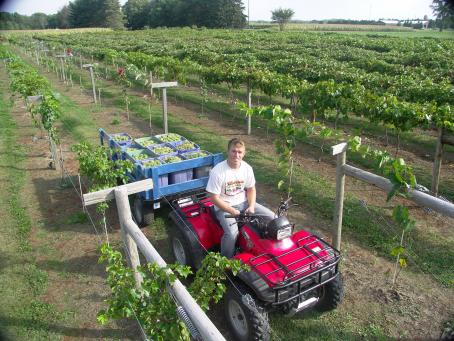Winemaking Process
Winemaking is not only an art, but also a science. It combines the process of fermentation with the creativity of the winemaker. The fermentation process starts when yeast is added to grape juice. The yeast consumes the grape's sugar and converts it to alcohol and carbon dioxide.
Each grape variety has its own identifiable characteristics. However, it is the winemaker who creates the style and personality of the finished wines. There is no fixed "recipe" for making certain wines, only general guidelines.
The winemaker "guides" the winemaking process using a variety of techniques to best express his or her style in each wine. These following stages depict the fundamentals of winemaking. The winemaker's options exist within this framework.

Harvest:
Harvest time is the defining moment in the winemaking process. Grapes are harvested during the cool morning hours and moved to the winery in open bins. At WineHaven, all of the grapes are harvested by hand to ensure that only the best grapes arrive at the winery. However, many wineries use machines to expedite the harvest process.
De-Stemmer/Crusher:
Grapes are transferred to a stemmer/crusher where the stems are removed and the grapes are crushed. Some grapes may bypass the stemmer/crusher and go directly to the press for whole berry pressing.
Fermentation:
After crushing and de-stemming, the juice from the grapes is put into the fermentation vats, where alcoholic fermentation takes place (the conversion of sugar into alcohol and CO2). At WineHaven, fermentation vats vary in size between 300 and 1200 gallons. Some wines are fermented in small oak barrels. Yeast is added to start fermentation.
WineHaven uses a wide variety of specialized wine yeasts from top sources in the United States, Germany, and France.
Ageing:
After fermentation, the wine is transferred or "racked" into a different vessel. In some instances, the wine is aged in stainless steel tanks. In other instances, the wine is put into oak barrels where it will continue its development until bottling. After barrel ageing and prior to bottling, the wines are fined and filtered to help stabilize and clarify them.
Bottling:
This is the last stage before the slow and relatively lengthy ageing process. Wines are bottled in a sterile environment, and sealed with a cork. At WineHaven, the air is removed from the bottle's headspace immediately before the cork is inserted.